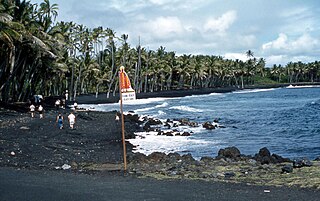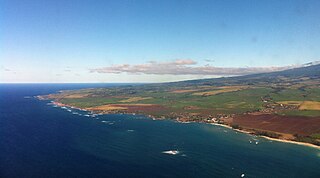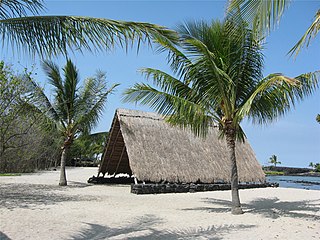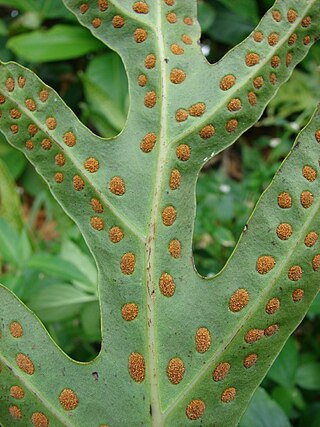
Kaimū was a small town in the Puna District on Island of Hawaiʻi that was completely destroyed by an eruptive flow of lava from the Kūpaʻianahā vent of the Kīlauea volcano in 1990. In Hawaiian, kai mū means "gathering [at the] sea" as to watch surfing. The lava flow that destroyed Kaimū and nearby Kalapana erupted from the southeast rift zone of Kīlauea.
The aliʻi were the traditional nobility of the Hawaiian islands. They were part of a hereditary line of rulers, the noho aliʻi.

ʻIolani Barracks, or hale koa in Hawaiian, was built in 1870, designed by the architect Theodore Heuck, under the direction of King Lot Kapuaiwa. Located directly adjacent to ʻIolani Palace in downtown Honolulu, it housed about 80 members of the monarch's Royal Guard until the overthrow of the Monarchy in 1893. It was added to the National Register of Historic Places in 1978 as part of the Hawaii Capital Historic District.

The Makahiki season is the ancient Hawaiian New Year festival, in honor of the god Lono of the Hawaiian religion.

Haiku is an unincorporated community in Maui County on the island of Maui in the state of Hawaii. For United States Census purposes, it is part of the Haiku-Pauwela census-designated place, which also includes Pauwela.

Kaloko-Honokōhau National Historical Park is a United States National Historical Park located in the Kona District on the Big island of Hawaiʻi in the U.S. state of Hawaiʻi. It includes the National Historic Landmarked archaeological site known as the Honokōhau Settlement. The park was established on November 10, 1978, for the preservation, protection and interpretation of traditional native Hawaiian activities and culture.

Pulu is a silky material obtained from the fibers of the hapuʻu pulu, a tree fern of Hawaii. It is made of the brown hairs that cover the young fiddlehead as it uncoils.

Hāʻena State Park is a state park on the north shore of the Hawaiian island of Kauaʻi. It is often called the "end of the road" and marks the endpoint of the Kuhio Highway. The park provides access to beaches, trails, and several ancient Hawaiian sites, including sea caves estimated to be more than 4,000 years old. Archaeological sites associated with the hula, including a heiau (shrine) dedicated to Laka, are above the park's beaches.

Kēōkea is an unincorporated populated place in Hawaiʻi County, Hawaii, United States. It is located at 19°25′10″N155°52′58″W, near the junction of Māmalahoa Highway and Keala o Keawe Road, elevation 960 feet (290 m). Satellite imagery shows evidence of a humid climate with agriculture dominant around the settlement. Just to the north is the area of Hōnaunau. It was the name for the land division (ahupuaʻa) of ancient Hawaiʻi that stretched from the shoreline to Mauna Loa owned by Mataio Kekūanaōʻa.

Samuel Mahuka Spencer was a Hawaiʻi island politician.

Metrosideros polymorpha, the ʻōhiʻa lehua, is a species of flowering evergreen tree in the myrtle family, Myrtaceae, that is endemic to the six largest islands of Hawaiʻi. It is a member of the diverse Metrosideros genus, which are widespread over the southwest Pacific. It is the state tree of Hawai‘i.

Makana is a mountain located on northern shore of the island of Kauaʻi, where it rises 1,115 feet (340 m) above Limahuli Valley. Makana is a Hawaiian language term meaning gift or reward. It is often used as a person's name or as part of a name. Limahuli Garden and Preserve preserves the valley below. It was featured in the 1958 film adaptation of the musical South Pacific as Bali Haʻi and is known by that name.
Lauhala, lau meaning "leaf" in the Hawaiian language, refers to the leaves of the hala tree (Pandanus tectorius).

The Hawaiian flagtails are species of the genus of flagtail fishes found in the Hawaiian Islands. Two species are Kuhlia sandvicensis and K. xenura. K. xenura is endemic to the islands.
Kamanawa II known as Kamanawa ʻŌpio or Kamanawa ʻElua was a Hawaiian high chief and grandfather of the last two ruling monarchs of the Kingdom of Hawaii, King David Kalākaua and Queen Lydia Makaeha Liliʻuokalani. His family had a good reputation until 1840, when he was convicted of murdering his wife.
Kealia is an unincorporated community on the island of Kauai in Kauai County, Hawaii, United States. Its elevation is 16 feet (5 m). The Board on Geographic Names officially designated it "Kealia" in 1914. It has a post office with the ZIP code 96751. James Wood Bush, a Hawaiian veteran of the American Civil War and later Mormon convert was a resident of Kealia.
Hoʻolauleʻa is a Hawaiian celebration or festival. A Hoʻolauleʻa may consist of authentic hula dancing and music, foods, vendors and games.
Kanikapila is a style of Hawaiian music produced in an impromptu jam session, most commonly taking place at a beach, or family gathering. The term comes from kani which means sound. and pila which means any string instrument in the Hawaiian language.

Microsorum scolopendria, synonym Phymatosorus scolopendria, commonly called monarch fern, musk fern, maile-scented fern, breadfruit fern, or wart fern is a species of fern within the family Polypodiaceae. This fern grows in the wild in the Western Pacific rim from Australia to New Caledonia to Fiji and throughout the South Pacific to French Polynesia.

Cibotium glaucum, the hāpu‘u pulu, is a species of fern in the family Cyatheaceae, native to Hawaii. A slow-growing tree fern typically 6 to 10 ft tall but reaching 25 ft (8 m), it is hardy in USDA zones 10 through 12. Its fiddleheads are the source of the material pulu, which means "mulch" or "padding" in the Hawaiian language Women used pulu as an absorbent during their menstrual cycles.

















